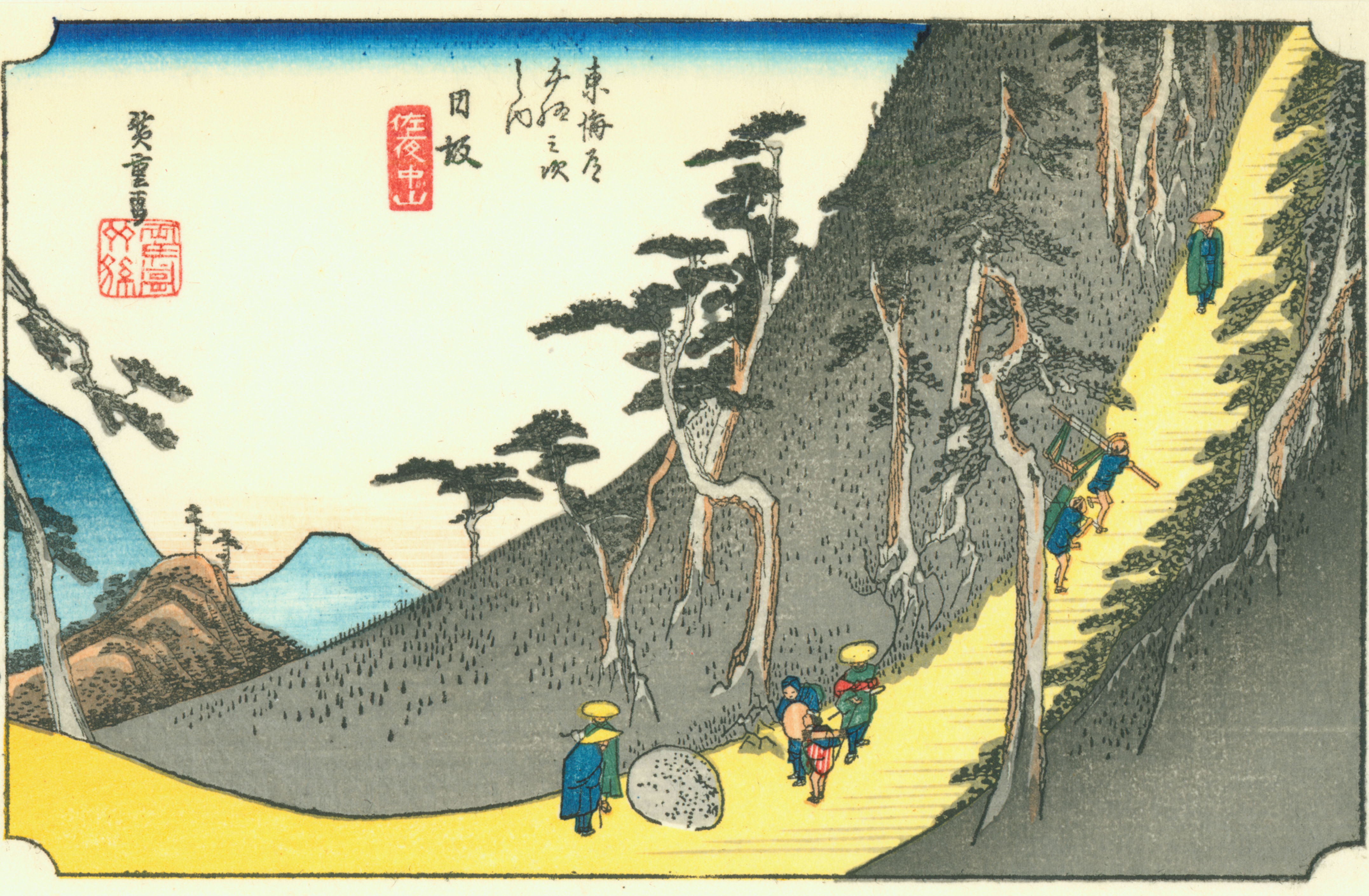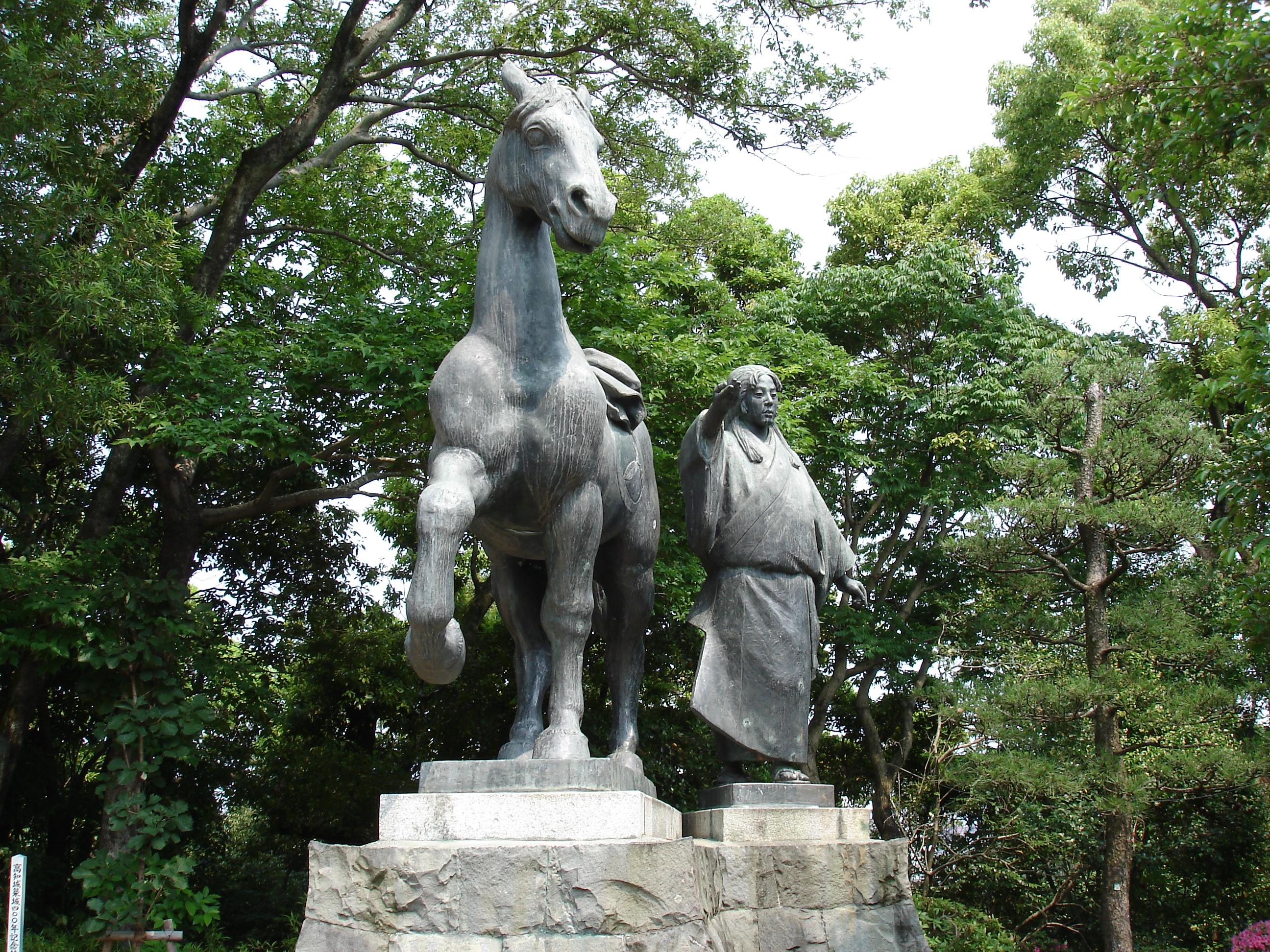|
Kakegawa-juku
was the twenty-sixth of the fifty-three stations of the Tōkaidō. It is located in what is now the city of Kakegawa, Shizuoka Prefecture, Japan. History Kakegawa-juku was originally the castle town of Kakegawa Castle. It was famous because Yamauchi Kazutoyo rebuilt the area and lived there himself. It also served as a post station along a salt road that ran through Shinano Province between the modern-day cities of Makinohara and Hamamatsu. The classic ukiyo-e print by Andō Hiroshige (''Hōeidō'' edition) from 1831–1834 depicts travelers crossing a trestle-bridge. An old couple is struggling against a strong wind, followed by a boy making a mocking gesture; another boy is watching a kite up in the air. In the background, peasants are planting rice and in the distance, Mount Akiba is shown in the mists. Neighboring post towns ;Tōkaidō : Nissaka-shuku - Kakegawa-juku - Fukuroi-juku was the twenty-seventh of the fifty-three stations of the Tōkaidō, making it the ... [...More Info...] [...Related Items...] OR: [Wikipedia] [Google] [Baidu] |
Fukuroi-juku
was the twenty-seventh of the fifty-three stations of the Tōkaidō, making it the center of the route. It is located in what is now the center of the city of Fukuroi, Shizuoka Prefecture, Japan. History Fukuroi-juku was developed later than most of the other post stations, as it was not established until 1616. It is 9.7 km from Kakegawa-juku, the preceding post town. At its peak, Fukuroi-juku was home to 195 buildings, including three ''honjin'' and 50 ''hatago''. Its total population was approximately 843 people. Because it was in the vicinity of the former Tōtōmi Province's three major temples, it also flourished as the gateway to the three temples. The three temples were: Hattasan Sonei-ji (法多山尊永寺), Kasuisai (可睡斎) and Yusan-ji (油山寺). The classic ukiyo-e print by Andō Hiroshige Utagawa Hiroshige (, also ; ja, 歌川 広重 ), born Andō Tokutarō (; 1797 – 12 October 1858), was a Japanese ''ukiyo-e'' artis ... [...More Info...] [...Related Items...] OR: [Wikipedia] [Google] [Baidu] |
Nissaka-shuku
was the twenty-fifth of the 53 Stations of the Tōkaidō, fifty-three stations of the Tōkaidō (road), Tōkaidō. It is located in what is now part of the city of Kakegawa, Shizuoka, Kakegawa, Shizuoka Prefecture, Japan. History Nissaka-shuku was located at the western entrance to , regarded as one of the three difficult mountain passes along the Tōkaidō. At the western entrance of Nissaka-shuku is . Originally, various characters were used for Nissaka, including 入坂, 西坂 and 新坂, as it had been nothing more than a small town located between Kanaya-juku on the banks of the Ōi River and Kakegawa-juku, a castle town that was an intersection along an old salt trading route. When Nissaka-shuku was established as part of the Tōkaidō at the start of the Edo period, the characters for its name officially became 日坂. The classic ukiyo-e print by Andō Hiroshige (''Hōeidō'' edition) from 1831–1834 depicts travellers on a steep road in forbidding dark mountains conte ... [...More Info...] [...Related Items...] OR: [Wikipedia] [Google] [Baidu] |
53 Stations Of The Tōkaidō
The are the rest areas along the Tōkaidō, which was a coastal route that ran from Nihonbashi in Edo (modern-day Tokyo) to Sanjō Ōhashi in Kyoto.. There were originally 53 government post stations along the Tōkaidō, where travelers had to present traveling permits at each station if wanting to cross. In 1619, the Ōsaka Kaidō (大阪街道) was developed to extend the Tōkaidō so that it would reach Kōraibashi in modern-day Osaka. Instead of going to Sanjō Ōhashi, travelers would leave from Ōtsu-juku and travel towards Fushimi-juku. Because of the addition of these four post towns, the Tōkaidō is occasionally referred to as having 57 stations. Another name for this extension was Kyōkaidō (京街道). The inland Nakasendō also started at Nihonbashi, and converged with the Tōkaidō at Kusatsu-juku. Shio no Michi intersected with the Tōkaidō at Okazaki-shuku. Stations of the Tōkaidō See also * Edo Five Routes ** 69 Stations of the Nakase ... [...More Info...] [...Related Items...] OR: [Wikipedia] [Google] [Baidu] |
Kakegawa, Shizuoka
is a city in western Shizuoka Prefecture, Japan. , the city had an estimated population of 117,925 in 45,519 households. The total area of the city is . Geography Kakegawa is in the coastal plains of southwest Shizuoka Prefecture. It is bordered to the south by the Pacific Ocean, and extends for approximately 30 kilometers north-south by 16 kilometers east-west. Surrounding municipalities *Shizuoka Prefecture ** Fukuroi ** Shimada ** Mori **Kikugawa ** Omaezaki Demographics Like most of Japan, Kakegawa's population is almost exclusively Japanese. However, Kakegawa has a noticeable ''Nikkei'' (particularly, South American) population and it is more common to find signs written in Portuguese than in English. Per Japanese census data, the population of Kakegawa has been increasing over the past 50 years. Climate The city has a climate characterized by hot and humid summers, and relatively mild winters (Köppen climate classification ''Cfa''). The average annual temperature ... [...More Info...] [...Related Items...] OR: [Wikipedia] [Google] [Baidu] |
Andō Hiroshige
Utagawa Hiroshige (, also ; ja, 歌川 広重 ), born Andō Tokutarō (; 1797 – 12 October 1858), was a Japanese ''ukiyo-e'' artist, considered the last great master of that tradition. Hiroshige is best known for his horizontal-format landscape series ''The Fifty-three Stations of the Tōkaidō'' and for his vertical-format landscape series '' One Hundred Famous Views of Edo''. The subjects of his work were atypical of the ''ukiyo-e'' genre, whose typical focus was on beautiful women, popular actors, and other scenes of the urban pleasure districts of Japan's Edo period (1603–1868). The popular series '' Thirty-six Views of Mount Fuji'' by Hokusai was a strong influence on Hiroshige's choice of subject, though Hiroshige's approach was more poetic and ambient than Hokusai's bolder, more formal prints. Subtle use of color was essential in Hiroshige's prints, often printed with multiple impressions in the same area and with extensive use of '' bokashi'' (color gradation) ... [...More Info...] [...Related Items...] OR: [Wikipedia] [Google] [Baidu] |
Ukiyo-e
Ukiyo-e is a genre of Japanese art which flourished from the 17th through 19th centuries. Its artists produced woodblock prints and paintings of such subjects as female beauties; kabuki actors and sumo wrestlers; scenes from history and folk tales; travel scenes and landscapes; flora and fauna; and erotica. The term translates as "picture of the floating world". In 1603, the city of Edo (Tokyo) became the seat of the ruling Tokugawa shogunate. The '' chōnin'' class (merchants, craftsmen and workers), positioned at the bottom of the social order, benefited the most from the city's rapid economic growth, and began to indulge in and patronise the entertainment of kabuki theatre, geisha, and courtesans of the pleasure districts; the term ("floating world") came to describe this hedonistic lifestyle. Printed or painted ukiyo-e works were popular with the ''chōnin'' class, who had become wealthy enough to afford to decorate their homes with them. The earliest ukiyo-e work ... [...More Info...] [...Related Items...] OR: [Wikipedia] [Google] [Baidu] |
Hamamatsu, Shizuoka
is a city located in western Shizuoka Prefecture, Japan. the city had an estimated population of 791,707 in 340,591 households, making it the prefecture's largest city, and a population density of . The total area of the site was . Overview Hamamatsu is a member of the World Health Organization’s Alliance for Healthy Cities (AFHC). Cityscapes File:Hamamatsu Castle, enkei-3.jpg, Hamamatsu Castle(2021) File:Views from Hamamatsu Castle20211002.jpg, City views from Hamamatsu Castle(2021) File:Hamamatsu view - panoramio.jpg, CBD of Hamamatsu File:Hamamatsu from Mount Tonmaku.jpg, Part of Hamamatsu Skyline File:Skyline of Hamamatsu01.jpg, Skyline of Hamamatsu File:Arco Mall Yurakugai in Hamamatsu City(2).jpg, Yūrakugai File:Night view of Hamamatsu city.jpg, Night view of Hamamatsu Geography Hamamatsu is southwest of Tokyo.Fukue, Natsuko.Nonprofit brings together foreign, Japanese residents in HamamatsuArchive. ''The Japan Times''. March 13, 2010. Retri ... [...More Info...] [...Related Items...] OR: [Wikipedia] [Google] [Baidu] |
Makinohara, Shizuoka
270px, Makinohara City Hall is a city located in western Shizuoka Prefecture, Japan. , the city had an estimated population of 45,813 in 16980 households and a population density of 410 persons per km². The total area of the city was . Geography Makinohara is located in south-central Shizuoka Prefecture. It is bordered by Suruga Bay on the Pacific Ocean to the east, and rises gradually to the Makinohara Plateau in the west. The area has a temperate maritime climate, characterized by hot, humid summers and mild winters, with the warm Kuroshio Current off shore providing a moderating effect. Surrounding municipalities Shizuoka Prefecture * Omaezaki * Kikugawa * Shimada * Yoshida, Haibara District Demographics Per Japanese census data, the population of Makinohara has been relatively steady over the past 50 years. Climate The city has a climate characterized by hot and humid summers, and relatively mild winters (Köppen climate classification ''Cfa''). The average annual te ... [...More Info...] [...Related Items...] OR: [Wikipedia] [Google] [Baidu] |
Shukuba
were post stations during the Edo period in Japan, generally located on one of the Edo Five Routes or one of its sub-routes. They were also called ''shuku-eki'' (宿駅). These post stations (or "post towns") were places where travelers could rest on their journey around the nation. They were created based on policies for the transportation of goods by horseback that were developed during the Nara and Heian periods. History These post stations were first established by Tokugawa Ieyasu shortly after the end of the Battle of Sekigahara. The first post stations were developed along the Tōkaidō (followed by stations on the Nakasendō and other routes). In 1601, the first of the Tōkaidō's fifty-three stations were developed, stretching from Shinagawa-juku in Edo to Ōtsu-juku in Ōmi Province. Not all the post stations were built at the same time, however, as the last one was built in 1624. The lodgings in the post stations were established for use by public officials an ... [...More Info...] [...Related Items...] OR: [Wikipedia] [Google] [Baidu] |
Shinano Province
or is an old province of Japan that is now Nagano Prefecture. Shinano bordered on Echigo Province, Echigo, Etchū Province, Etchū, Hida Province, Hida, Kai Province, Kai, Kōzuke Province, Kōzuke, Mikawa Province, Mikawa, Mino Province, Mino, Musashi Province, Musashi, Suruga Province, Suruga, and Tōtōmi Province, Tōtōmi Provinces. The ancient capital was located near modern-day Matsumoto, Nagano, Matsumoto, which became an important city of the province. The World War II–era Japanese aircraft carrier Japanese aircraft carrier Shinano, ''Shinano'' was named after this old province. Historical record In 713, the road that traverses Mino Province, Mino and Shinano provinces was widened to accommodate increasing numbers of travelers through the Kiso District, Nagano, Kiso District of modern Nagano Prefecture. In the Sengoku period, Shinano Province was often split among fiefs and castle towns developed, including Komoro, Nagano, Komoro, Ina, Nagano, Ina, and Ueda, Naga ... [...More Info...] [...Related Items...] OR: [Wikipedia] [Google] [Baidu] |
Yamauchi Kazutoyo
, also spelled Yamanouchi (1545/1546? – November 1, 1605). He was retainer of Oda Nobunaga and later Toyotomi Hideyoshi. His father Yamauchi Moritoyo, was a descendant of Fujiwara no Hidesato, a senior retainer of the Iwakura Oda clan (opposed to Oda Nobunaga), and lord of Kuroda castle in Owari Province at the end of the Sengoku period of Japan. He was famous as the husband of Yamauchi Chiyo. Military life When he was still a 400-Koku lord, many great people as children were entrusted to him, such as Kuroda Nagamasa when he was hostage of Oda Nobunaga and Toyotomi Hidetsugu were taught by him. He participated at Battle of Anegawa 1570 in the Oda's side. After the Siege of Odawara (1590) and the rise to power of Toyotomi Hideyoshi, Tokugawa Ieyasu was forced to trade his domains in the Tōkai region for the Kantō region instead. Kazutoyo was relinquished Kakegawa Castle from Hideyoshi. In 1600, Kazutoyo fought at the Battle of Sekigahara on Tokugawa Ieyasu's side. Aft ... [...More Info...] [...Related Items...] OR: [Wikipedia] [Google] [Baidu] |




_Awa_Naruto_no_fuukei.jpg)


